#zora rux
Text

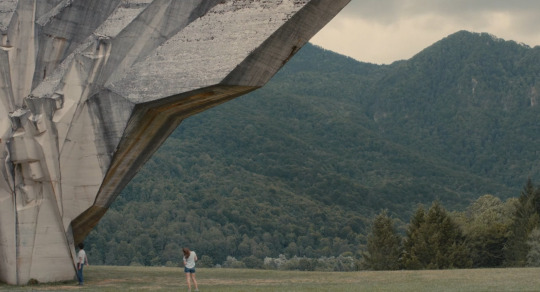



Ich Ich Ich / Second Thoughts
Zora Rux. 2021
Memorial
Dolina Heroja, Tjentište, Bosnia and Herzegovina
See in map
See in imdb
Bonus: also in this location
#zora rux#ich ich ich#second thoughts#memorial#sculpture#bonus#henriette confurius#thomas fränzel#bosnia and herzegovina#tjentište#dolina heroja#ranko radović#concrete#brutalism#movie#cinema#film#location#google maps#street view#2021
114 notes
·
View notes
Text
Second Thoughts

Second Thoughts [trailer]
Marie, early thirties, gets a wedding proposal from her boyfriend. Overwhelmed, she goes for the honest way: She has to think about it.
The movie deals with relationship questions in a very amusing way. It takes a while to get used to, but I found it quite funny with the overlapping voices, statements and commentary by various characters. Giving their opinion or commenting on the situations, often breaking the fourth wall.
When the scene described in the summary takes place I wanted to stand up and applaud. I always think putting pressure on someone in such an exposed, public situation is insane. It's like an ambush.
#Second Thoughts#Ich Ich Ich#Zora Rux#Elisa Plüss#Thomas Fränzel#Henriette Confurius#Lola Klamroth#Sebastian Schneider#like#recommended#foreign#Germany
0 notes
Video
youtube
Die Berlinerin Zora Rux und Elisa Plüss über ICH ICH ICH
3 notes
·
View notes
Text
Richard Bruce Nugent









Richard Bruce Nugent (July 2, 1906 – May 27, 1987), aka Richard Bruce and Bruce Nugent, was a writer and painter in the Harlem Renaissance. One of many gay artists of the Harlem Renaissance, he was one of few who was out publicly. Recognized initially for the few short stories and paintings that were published, Nugent had a long productive career bringing to light the creative process of gay and black culture.
Biography
Richard Bruce Nugent was born in Washington, DC on July 2, 1906 to Richard H. Nugent, Jr., and his wife Pauline Minerva Bruce. After attending Dunbar High School, he moved to New York after his father's death in 1920. The majority of his life and career took place in Harlem in New York City, and he died on May 27, 1987 in Hoboken, New Jersey.
During his career in Harlem, Nugent lived with writer Wallace Thurman from 1926 – 1928 which led to the publishing of “Smoke, Lilies, and Jade” in Thurman's publication “Fire!!!”. The short story was written in a modernist stream-of-consciousness style, its subject matter was bisexuality and more specifically interracial male desire.
Many of his illustrations were featured in publications, such as “Fire!!!” along with his short story. Four of his paintings were included in the Harmon Foundation's exhibition of Negro artists, which was one of the few venues available for black artists in 1931. His only stand-alone publication, “Beyond Where the Stars Stood Still," was issued in a limited edition by Warren Marr II in 1945. He later married Marr's sister, Grace on December 5, 1952.
His marriage to Grace Marr lasted from 1952 until her suicide in 1969. Nugent's intentions with the marriage were unclear as they were not romantic due to his clearly stated interest in other men. Thomas Wirth, contemporary and personal friend of Richard Nugent claimed that Grace loved Richard and was determined to change his sexuality in “Gay Rebel of the Harlem Renaissance: Selections from the Work of Richard Bruce Nugent” 2002
He attended the Community Planning Conference at Columbia University in 1964 as an invited speaker. The conference was held under the auspices of the Borough President of Manhattan/Community Planning Board 10 and Columbia University. The idea of forming an organization to promote the arts in Harlem emerged from the conference’s Cultural Planning workshop and led to the formation of the Harlem Cultural Council. Nugent took an active role in this effort and attended numerous subsequent meetings. Nugent was elected co-chair (a position equivalent to vice president) of this council. He also served as chair of the Program Committee until March 1967.
Legacy
Nugent's aggressive and honest approach to homoerotic and interracial desire was not necessarily in the favor of his more discreet homosexual contemporaries. Alain Locke chastised the publication “Fire!!!” for its radicalism and specifically Nugent's “Smoke Lilies, and Jade” for promoting the effeminacy and decadence associated with homosexual writers.
Nugent's group of friends, made up of Langston Hughes, Zora Neale Hurston, Aaron Douglas, Gwendolyn Bennett, and John P. Davis, all frequented "Niggerati Manor," which was where they socialized with each other as well as where the origination of "Fire!!!" was based. As well as his friends, Nugent was also influenced by the likes of Aaron Douglas and Georgia Douglas Johnson. These people's aesthetics were seen in his work. They also helped get his work into various magazines for exposure.
Nugent's work resurfaced in anthologies such as Michael J. Smith's “Black Men/White Men: A Gay Anthology" (1983), and Joseph Beam's interview with Nugent in “In The Life: A Black Gay Anthology” (1986). His work after its resurfacing brought to light the lifestyle of black gay artists during the Harlem Renaissance. His use of codes made much of his work pass unseen by straight contemporaries under the disguise of biblical imagery for example. Nugent bridged the gap between the Harlem Renaissance and the black gay movement of the 1980s and was a great inspiration to many of his contemporaries.
Bibliography
Shadow
My Love
Narcissus
Incest
Who Asks This Thing?
Bastard Song
Sahdji
Smoke, Lilies and Jade
The Now Discordant Song of Bells
Slender Length of Beauty
Tunic with a Thousand Pleats
Pope Pius the Only
On Harlem
On Georgette Harvey
On Gloria Swanson
Lunatique
Pattern for Future Dirges
Popular Culture
Film
As one of the last survivors of the Harlem Renaissance, Nugent was a sought-after interview subject in his old age, consulted by numerous biographers and writers on both black and gay history. He was interviewed in the 1984 gay documentary, “Before Stonewall,” and his work was featured in Isaac Julien’s 1989 film, Looking for Langston.
Brother to Brother is a film written and directed by Rodney Evans and released in 2004. The film debuted at the 2004 Sundance Film Festival before playing the gay and lesbian film festival circuit, with a limited theatrical release in late 2004.The film is concerns an art student named Perry (Anthony Mackie) who befriends an elderly homeless man named Bruce Nugent (Roger Robinson), who turns out to have been an important figure in the Harlem Renaissance. Through recalling his friendships with other important Harlem Renaissance figures such as Langston Hughes, Aaron Douglas, Wallace Thurman and Zora Neale Hurston, Bruce chronicles some of the challenges he faced as a young, black, gay writer in the 1920s. Perry discovers that the challenges of homophobia and racism he faces in the early 21st century closely parallel Bruce's.
Theater
Smoke Lilies & Jade is a Bildungsroman (coming-of-age) play by writer Carl Hancock Rux. Loosely based on Nugent's 1926 short story, "Smoke, Lilies and Jade" (as well as elements of Richard Bruce Nugent's own life) the play concerns the psychological and moral growth of its protagonist Alex as he reflects on his love for a man named "Beauty" and a woman named "Melva", as well as the relationships, injustices and tragedies that eventually befell him and many of the Jazz Age's African American artists and intellectuals. The play was initially commissioned by The Joseph Papp Public Theater and later produced by the CalArts Center for New Performance.
Wikipedia
5 notes
·
View notes
Photo

It’s the end of the first week of Summer B. How are you doing, Knight? Hanging in there so far? To give you something interesting for the weekend, we have two streaming video suggestions: Brooklyn Boheme (2011) and Illusions (1982)
~
Brooklyn Boheme (Diane Paragas & Nelson George, 2011)
As contributions by black artists are coming into greater focus given the larger attention social tensions have been getting in recent weeks, nearly a decade ago noted author Nelson George hosted and co-directed Brooklyn Boheme, a documentary that looked at his own Brooklyn neighborhood of Fort Green (and adjacent Clinton Hill) and the wealth of artistic output that emerged in that area during the 80s, 90s, and beyond.
That time and place saw a flourishing of culture that caused many to describe it as a modern Harlem Renaissance. Author and activist Kevin Powell said when he moved to New York, he first settled in Harlem, expecting the Harlem of Langston Hughes and Zora Neale Hurston. He left after eventually finding that in Fort Green. Some of those he found there were or would become household names: Branford Marsalis, Chris Rock, Rosie Perez, Mos Def, Spike Lee. Others were less widely known, but no less influential in the culture: writer Carl Hancock Rux, artist Lorna Simpson, poet Saul Williams.
A particular pet peeve of mine when it comes to this type of documentary is when the filmmaker inserts oneself into the story, making them as much of the subject as the actual subject. And while we certainly get a sense of how tapped into the overall community he was during this time, George is reticent to highlight his own contribution to this culture to the point where I actually wished he was more willing to toot his own horn. As someone whose cultural sensibilities were forming in the late 80s and early 90s, George was a face I often saw on the likes of MTV and VH1. His thoughts on music helped shaped the way I looked at the culture in those formative years. That it was his friends and neighbors helping create that culture only made him more in tune to how to contextualize it all. It's a testament to his humility that he focuses on the other figures of this movement rather than himself.
And that's really one of the more heartwarming things about the doc. There was a real sense of community here. It was never about competition, only about supporting each other (even with Spike Lee's hilarious but good-natured ribbing towards the spoken word scene at the Brooklyn Moon Cafe). More than once in the movie did George and whomever he was interviewing while walking down the street run into another figure in this culture. So many of these people were real friends and neighbors. Essentially George is writing a love letter to his beloved neighborhood. Or better yet, throwing a really cool cinematic block party.
Brooklyn Boheme is available through Alexander Street Press.
~
Illusions (Julie Dash, 1982)
Remarkably, it took nearly the entirety of the 20th century to see a movie directed by an African American woman see a wide theatrical release when Julie Dash's Daughters of the Dust came out in 1991. Her 1982 short, Illusions, helped illuminate some of the many struggles women of color have had in Hollywood.
Illusions is about Mignon, a light-skinned black woman who passes for white at her job at the fictional National Studios in WWII-era Hollywood. Though her position is nothing more than a high-ranking secretary, her talent has given her some power in many of the studio's productions. She's been left in charge of overseeing the dubbing of a white actress in a musical by a Black singer, Esther. She begs her boss to let her produce films herself, but of course having crossed over to white isn't enough. Women of all colors tend not to get the chance to run the show.
It certainly isn't a coincidence that Dash sets this story in 1942. Hollywood is an engine of propaganda and studios were creating pictures with a deep sense of nationalism during the Second World War. That Mignon is both a victim and a perpetrator of the illusions of Hollywood highlights an aspect of the Black experience not discussed in many films—that of colorism. Most films dealing with the African American experience that makes its way into mainstream discourse are about slavery or civil rights. As good as many of those movies are, they are obvious stories with obvious moral stakes. Illusions is aware that the discussion needs to be more nuanced and complex. Dash knew then what so many of us are only starting to realize now.
Illusions is available through Kanopy.
0 notes
Text
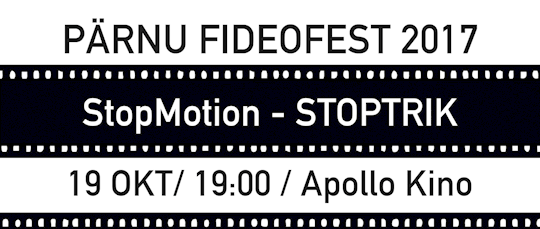

Sinu seinte sees / Within Thy Walls / שאלוה†לשלומה
Omer Sharon, Daniella Schnitzer (Bezalel Academy of Art and Design)
2015, ISR, 7'17''
A city portrait of the complicated daily life in Jerusalem.
Jeruusalemma keeruka igapäevaelu linna portree.
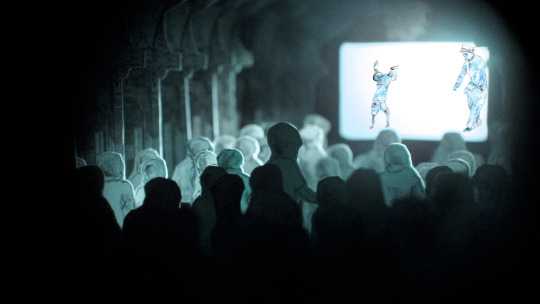
Mr Sand
Soetkin Verstegen
2016, DEN/BEL, 8'15''
A dreamy animated documentary about the dangers of early cinema. The atmosphere of old film theatres is recalled through a mixture of handmade techniques.
Unikaalne animeeritud dokumentaalfilm varajase kino ohtudest. Vanade kinoteatrite atmosfäär taastatakse käsitsi valmistatud tehnikate segu abil.

Mis juhtub teie ajus, kui näete saksa sõna nagu ... ¿ /
What Happens in Your Brain If You See a German Word Like…¿
Zora Rux (dffb German Film and Television Academy Berlin)
2015, GER, 5'
A surreal trip into the world of an extremely long German word. The Borderlands Competition Maribor Grand Prix and Maribor Students Jury Borderlands Award.
Sürreaalne reis äärmiselt pikka saksa sõna maailma. Maribor Grand Prix ja Maribori žürii Borderlands auhinnaga pärjatud teos.
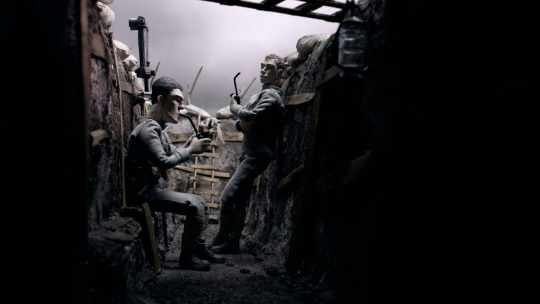
Steinway/ Lo Steinway
Massimo Ottoni (Istituto Luce Cinecittà)
2016, ITA, 17'30''
During WWI a group of Austrian soldiers on the Italian front find a piano in a ruin. The instrument catalyzes most human feelings but the meaningless barbarity they try to forget is always ready to burst.
I maailmasõja ajal leidis Itaalia sõjaväe Austria sõdurite rühmitus varemetest klaveri. Instrument katalüüsib kõige inimlikumaid tundeid, kuid nende mõttetu barbaarsus, mida nad püüavad unustada, on alati valmis välja purskuma.

Nüüd on see läbi / Now It's Over
Dave Merson Hess (Night Heron)
2015, USA, 4'37''
The broad variety of visual styles (stop motion with paper puppets, ink on paper, watercolor, and paint-on-glass) in a tribute to French and Japanese New Wave auteurs of the late ’60s. Music: A Place to Bury Strangers.
Visuaalsete stiilide lai varieering (stop motion pabernukud, tint paberil, akvarell ja värv klaasil), austusega Prantsuse ja Jaapani New Wave pioneeridele 60ndate lõpust.
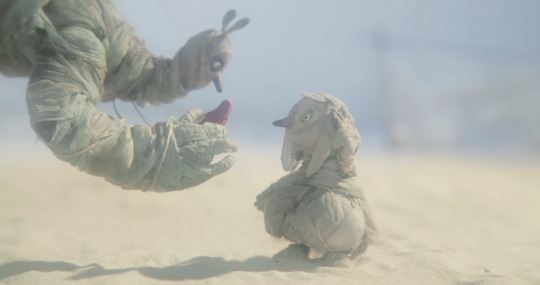
Kukuschka/ КУКУШКА
Dina Velikovskaya ("Pchela" Studio)
2016, RUS, 8'45''
Kukuschka is a bird who follows the sun. It seems as she can almost touch it, but the Sun is still far away. Suddenly she is not alone anymore, but for two it's even more difficult to keep going so fast.
Kukuschka on lind, kes järgneb päikele. Tundub, nagu saaks ta seda peaaegu puudutada, kuid Päike on ikkagi liiga kaugel. Äkki polegi ta enam üksi, kuid kahekesi on veelgi raskem nii kiiresti liikuda.
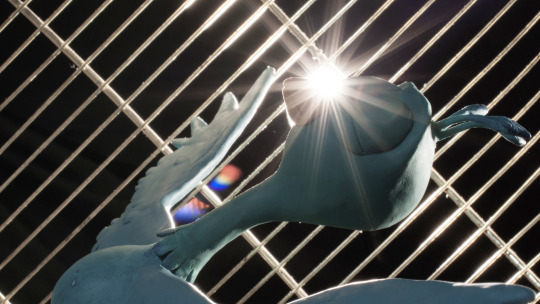
The Feardom
Pablo Muńoz Naharro (Pangur Animation)
2016, ESP, 2'08''
The story about fear, hope, opportunity, changes, growth and many other things one must beware of. Starring nice bluebird.
Lugu hirmust, lootusest, võimalustest, muutustest, kasvust ja paljudest muudest asjadest millest peaks teadlik olema. Peaosas kena sinilind.

Tango
Francisco Gusso, Pedro Giongo (Estudio Tijucas)
2015, BRA, 14'
After years of drought, a mystic potato sprouts in the remote springs of the Aiatak River. Soon, everything will be ready for the great ritual of Tango. Inspired by Franz Kafka's "A Hunger Artist"
Pärast aastate pikkust põuda, müstilised kartulipõrsad Aiataki jõe lättel. Varsti on kõik valmis Tango suureks rituaaliks. Lugu on inspireeritud Franz Kafka "Näljakunstnik" ainetel.
Sissepääs tasuta / Free entry
0 notes